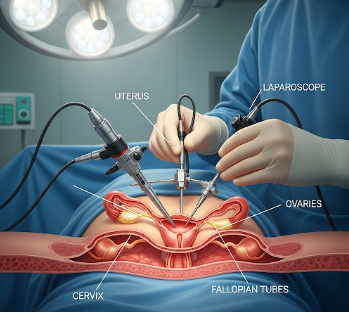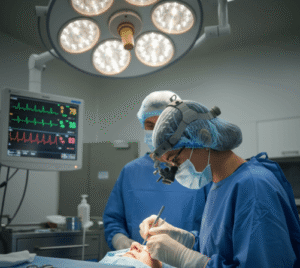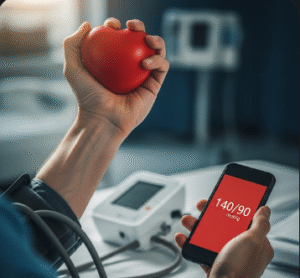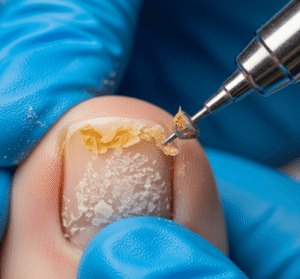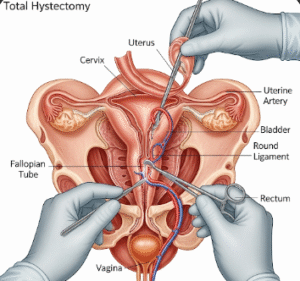Overview
Laparoscopic Subtotal Hysterectomy is a minimally invasive surgical procedure to remove the upper part of the uterus while leaving the cervix intact. This surgery is typically performed to treat uterine fibroids, abnormal bleeding, or other benign uterine conditions, while preserving the cervix for potential pelvic support.
In Korea, this procedure is performed by experienced gynecologic surgeons using advanced laparoscopic techniques, resulting in smaller incisions, less pain, faster recovery, and improved cosmetic outcomes.
Highlights:
- ✅ Removal of the uterus while preserving the cervix
- ✅ Minimally invasive with reduced pain and scarring
- ✅ Faster recovery and shorter hospital stay
What is Laparoscopic Subtotal Hysterectomy?
Laparoscopic Subtotal Hysterectomy involves making small incisions in the abdomen to insert a laparoscope and surgical instruments. The upper portion of the uterus is detached and removed, leaving the cervix intact. The procedure addresses uterine pathology while maintaining structural and pelvic support.
Indications include:
- Uterine fibroids causing pain or heavy bleeding
- Adenomyosis or abnormal uterine bleeding
- Benign uterine conditions requiring surgical intervention
- Patients wishing to preserve the cervix for pelvic floor support
Important: This surgery does not remove the cervix, so cervical cancer screening (Pap smears) must continue after the procedure.
What are the benefits?
- Minimally invasive: Smaller incisions, less postoperative pain, and faster recovery
- Preservation of cervix: Maintains pelvic support and reduces risk of prolapse
- Quick recovery: Most patients return to normal activities within a few weeks
- Improved quality of life: Relief from symptoms such as heavy bleeding, pain, and pressure
Key benefits highlighted:
- ⚡ Shorter hospital stay compared to open hysterectomy
- ⚡ Reduced surgical trauma and scarring
- ⚡ Preservation of pelvic floor stability
- ⚡ Faster return to daily activities and work
Procedure Details
1) How should I prepare for Laparoscopic Subtotal Hysterectomy?
- Preoperative evaluation: Ultrasound, MRI if needed, blood tests, and pelvic examination
- Medication review: Stop blood thinners or other medications as advised
- Fasting: Usually 6–8 hours before surgery
- Consent and education: Discuss procedure, risks, benefits, and recovery
- Lifestyle preparation: Maintain optimal nutrition and avoid smoking for better healing
2) What happens during Laparoscopic Subtotal Hysterectomy?
- Anesthesia: General anesthesia administered
- Incision and port placement: 2–4 small incisions made in the abdomen
- Uterus removal: Upper uterus detached and removed while preserving the cervix
- Hemostasis and inspection: Bleeding controlled, surrounding tissues checked
- Closure: Incisions closed with sutures or adhesive strips; laparoscopic ports removed
Duration: Typically 1–2 hours depending on patient anatomy and complexity
3) What happens after Laparoscopic Subtotal Hysterectomy?
- Recovery monitoring: Vital signs and incision sites observed in hospital
- Pain management: Analgesics prescribed for mild discomfort
- Activity: Gradual return to normal activities; avoid heavy lifting for several weeks
- Follow-up care: Monitor incision healing, uterine and pelvic recovery, and any complications
Highlights for post-procedure care:
- ⚡ Mild abdominal pain, cramping, or shoulder tip discomfort may occur
- ⚡ Small scars will heal over 1–2 weeks
- ⚡ Avoid strenuous activity for 2–4 weeks
- ⚡ Attend follow-up appointments for monitoring and guidance
Risks / Benefits
Risks:
- Infection or bleeding
- Damage to surrounding organs (bladder, bowel, ureters)
- Rare anesthesia-related complications
- Ongoing cervical screening required since the cervix is retained
Benefits:
- Minimally invasive with faster recovery
- Relief from uterine symptoms (fibroids, abnormal bleeding)
- Preservation of cervix and pelvic floor support
- Reduced postoperative pain and smaller scars
Recovery and Outlook
- Hospital stay: Usually 1 day or outpatient depending on patient condition
- Full recovery: 2–4 weeks for most patients
- Long-term outlook: Excellent symptom relief and improved quality of life
- Follow-up: Regular postoperative visits to monitor healing and continued cervical screening
Tips for optimal recovery:
- ✅ Follow all postoperative care instructions
- ✅ Avoid heavy lifting or strenuous activity
- ✅ Keep incisions clean and dry
- ✅ Attend follow-up visits for assessment and guidance
When To Call the Doctor
- Fever, chills, or signs of infection
- Severe abdominal pain not relieved by medication
- Unusual bleeding or discharge from incision sites
- Difficulty urinating or bowel issues
Best Korea Option / Process
Korea provides advanced laparoscopic subtotal hysterectomy care:
- Top hospitals: Specialized gynecologic surgery centers with experienced surgeons
- Advanced diagnostics: Ultrasound, MRI, and blood tests for precise planning
- Minimally invasive techniques: Laparoscopic approach for smaller incisions, less pain, and faster recovery
- Postoperative care: Pain management, activity guidance, and follow-up monitoring
- International patient support: Online consultations, appointment scheduling, and telemedicine follow-up
Step-by-step process in Korea:
- Online consultation and preoperative assessment
- Pre-surgery preparation and fasting instructions
- Laparoscopic subtotal hysterectomy performed by expert gynecologic surgeons
- Postoperative monitoring, pain management, and gradual activity resumption
- Follow-up appointments to ensure healing and continued cervical screening

